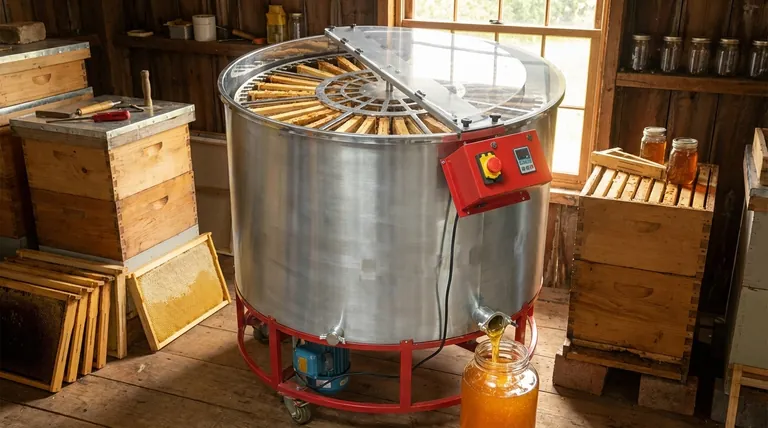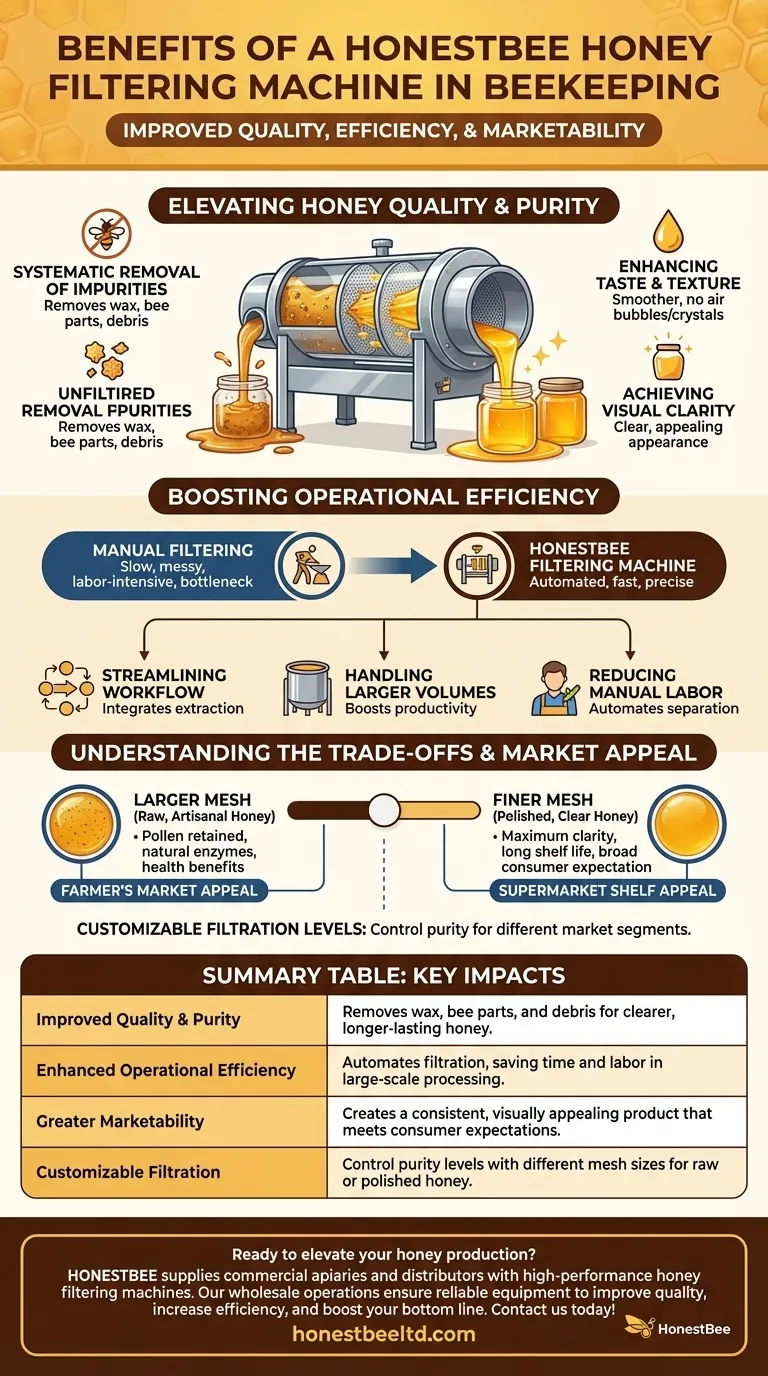The primary benefits of a honey filtering machine are significantly improved product quality, greater operational efficiency, and enhanced marketability. By systematically removing impurities such as wax, bee parts, and debris, the machine produces honey that is clearer, has a more consistent texture, and a longer shelf life, making it more appealing to consumers and easier to sell.
The core challenge in honey processing is separating pure honey from the natural debris of the hive. A honey filtering machine automates this separation, giving the beekeeper precise control over the final product's purity and appearance, which directly elevates its commercial value.

Elevating Honey Quality and Purity
A filtering machine's main purpose is to refine the raw product extracted from the honeycomb into something pure and consistent.
Systematic Removal of Impurities
The machine filters the honey to methodically remove unwanted particulates. This includes wax cappings, bee parts, pollen grains, and other hive debris that inevitably mix with the honey during extraction.
The result is a fundamentally cleaner product, free from foreign materials.
Enhancing Taste and Texture
Removing these particles creates a smoother, more pleasant texture. It also ensures that the honey's pure taste is not affected by the presence of wax or other debris.
This process eliminates air bubbles and prevents the formation of sugar crystals, ensuring a consistently smooth final product.
Achieving Visual Clarity
Unfiltered honey can often appear cloudy due to suspended particles. The filtering process removes this cloudiness, resulting in the brilliantly clear, liquid-gold appearance that many consumers expect.
This visual appeal is a key factor in a customer's purchasing decision.
Boosting Operational Efficiency
For any beekeeper beyond a small hobbyist, manual filtering is a significant bottleneck. A machine transforms this part of the process.
Streamlining the Extraction Workflow
Many machines integrate extraction (spinning honey from the comb) and filtration into a single, streamlined process. This saves considerable time and effort compared to performing these tasks separately.
Handling Larger Volumes
For commercial or large-scale operations, a machine is essential. It can process a significant volume of honey far more quickly and effectively than any manual method, boosting overall productivity.
Reducing Manual Labor
Manual filtration involves straining honey through layers of cheesecloth or screens, a slow and messy job. A machine automates this entirely, freeing up the beekeeper's time for other critical tasks.
Understanding the Trade-offs
While filtering provides many benefits, it also involves choices that affect the final product. The key is understanding what you are trying to achieve.
Customizable Filtration Levels
These machines are not an all-or-nothing tool. Beekeepers can use filters with different mesh sizes to customize the level of filtration.
A larger mesh will remove big debris like wax and bee parts while leaving most pollen. A finer mesh will remove almost everything, creating perfectly clear honey.
The Pollen Debate
One of the most significant trade-offs is the removal of pollen. While some consumers demand crystal-clear honey, others seek out the potential health benefits of raw honey that still contains its natural pollen.
Using a machine gives you control. You can decide whether to produce highly filtered honey for maximum clarity or minimally filtered honey to retain these elements for a different market segment.
Meeting Market Expectations
The ideal level of filtration depends entirely on your target customer. A product destined for a supermarket shelf often requires high clarity, whereas honey sold at a farmer's market may be valued for being less processed.
Making the Right Choice for Your Operation
Your decision to use a filtering machine and how you use it should be aligned with your specific goals.
- If your primary focus is producing artisanal, raw honey: Use the machine with a larger mesh filter to efficiently remove major debris while retaining the valuable pollen and enzymes that define a "raw" product.
- If your primary focus is maximizing commercial appeal and shelf life: Opt for finer mesh filtration to produce exceptionally clear, consistent honey that meets broad consumer expectations for a polished and visually perfect product.
- If your primary focus is scaling your beekeeping operation: A filtering machine is a non-negotiable investment to increase your processing capacity, reduce labor costs, and ensure a consistent product standard across large batches.
Ultimately, a honey filtering machine offers precise control, transforming a variable natural product into a consistent, high-quality asset.
Summary Table:
| Benefit | Key Impact |
|---|---|
| Improved Quality & Purity | Removes wax, bee parts, and debris for clearer, longer-lasting honey. |
| Enhanced Operational Efficiency | Automates filtration, saving time and labor in large-scale processing. |
| Greater Marketability | Creates a consistent, visually appealing product that meets consumer expectations. |
| Customizable Filtration | Control purity levels with different mesh sizes for raw or polished honey. |
Ready to elevate your honey production? HONESTBEE supplies commercial apiaries and beekeeping equipment distributors with high-performance honey filtering machines and supplies. Our wholesale-focused operations ensure you get the reliable equipment you need to improve product quality, increase efficiency, and boost your bottom line. Contact us today to discuss your needs and get a quote!
Visual Guide

Related Products
- HONESTBEE 72 Frame Industrial Electric Honey Extractor for Beekeeping
- Professional Thermostatic Conical Honey Melter
- 8-Frame Electric Self-Reversing Honey Extractor Spinner for Commercial Honey Extraction Equipment
- Honey Concentrating Vacuum Heating Thickening Machine Dehumidifier for Honey
- High Quality Honey Dehumidifier Dryer Thickening Machine for Beekeeping
People Also Ask
- Why is preserving honeycomb integrity important, and how do automated extractors help? Boost Hive Health & Honey Yields
- Can a manual extractor be upgraded to an electric one? Save Labor & Boost Efficiency
- What is the energy consumption like for automatic honey extractors? Maximize Your Harvest Efficiency
- What are the two common types of honey extractors? Choose the Right Extractor for Your Apiary
- How do automatic honey extractors function? Achieve High-Efficiency Honey Harvesting



















